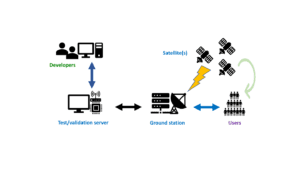

Considering 90° local pitch angle electrons, Fig. HEP is equipped with two types of telescope, HEP-L (70 keV ~ 1 MeV) and HEP-H (0.7 ~ 2 MeV) (Mitani et al. 1h) of ERG, which was orbiting near the magnetic equator at radial distances shorter than GEO. At ~ 22:30 UT, significant enhancement of electron differential fluxes was observed by the High-energy Electron exPeriments (HEP) (Fig. The gradual dipolarization signatures and duration were similar to the second substorm injection in Gkioulidou et al. ERG observed a nearly dispersionless, namely not perfectly dispersionless, injection accompanied by a gradual increase of B z instead of a sharp dipolarization. The apogee and perigee altitudes of ERG orbit were \(\sim6 R_\) components observed at ERG positions. The magnetospheric spacecraft, ERG, was successfully launched by the Epsilon launch vehicle from the JAXA Uchinoura Space Center on December 20, 2016. But the Exploration of energization and Radiation in Geospace (ERG, nicknamed Arase) spacecraft also observed a substorm injection event at radial distances shorter than GEO during a special period of the mission. Particle injections associated with substorms were usually studied based on observations at the geosynchronous orbit (GEO).

The substorm injection expanding earthward farther than GEO was observed by ERG, and the event can be better simulated by the further-developed model shown in this work. Despite possible deviation of the model magnetic fields from reality, the relativistic computations still show dominant effect on the drift echoes periods. Our work shows that the main features of the substorm injection event are successfully reproduced with the drift echoes periods showing a better fit to the observations of this event when relativistic effects are considered. Since the electron energies of interest are comparable to the rest mass energy, our work further provides the relativistic form of the previous model and employs a semiempirical model as background field instead of a dipole-based one in the previous study. ERG and GOES spacecraft measured tens to a few hundred keV electrons injected during the substorm, providing important seed population for ring current and radiation belts. To study the substorm injection event and produce drift echoes with better periods, we modify an existing model in the literature. So far such models showed good results of dispersionless features compared to spacecraft observations, but could only produce drift echoes with periods somewhat different from geosynchronous observations. Models built on an impulsive earthward-propagating electromagnetic field have been proposed to simulate substorm injections. The observations provided constraints to study the event and opportunities to make adjustments to the previous substorm injection models. The GOES-15 and GOES-13 measured the drift echoes of the event as well. ERG successfully observed a clear and sufficient extent of manifestations of the dispersionless injection and the successive drift echoes at radial distances shorter than geosynchronous orbit (GEO) during a unique period of the satellite mission. 5, 2017, was observed by the ERG (Arase), GOES-15 and GOES-13 spacecraft. Over the years, RHESSI documented the huge range in solar flare size, from tiny nanoflares to massive superflares that were tens of thousands of times bigger and more explosive.Substorm-associated electron injection, starting on Apr. Results A sub-ion-gyro-scale limb compression on JanuFigure 1shows a short-period magnetic enhancement found in a two-hour summary plot of the 1 s averaged magnetic field observed by Kaguya on 1 January 2008.

#OMNIWEB SPACECRAFT DATA PLUS#
These solar events release the energy equivalent of billions of megatons of TNT into the sun’s atmosphere within minutes and can have effects on Earth, including the disruption of electrical systems. OMNIWeb Plus data were used in cases where ACE Level 2 data were not available. From its former perch in low-Earth orbit, the satellite captured images of high-energy electrons that carry a large part of the energy released in solar flares, NASA said.īefore RHESSI, no gamma-ray images or high-energy X-ray images had been taken of solar flares, and data from the spacecraft provided vital clues about the phenomena and their associated coronal mass ejections. The spacecraft was equipped with an imaging spectrometer, which recorded the sun’s X-rays and gamma rays. Webb telescope captures glowing starburst as galaxies collide Shining like a brilliant beacon amidst a sea of galaxies, Arp 220 lights up the night sky in this view from NASA's James Webb Space Telescope.


 0 kommentar(er)
0 kommentar(er)
